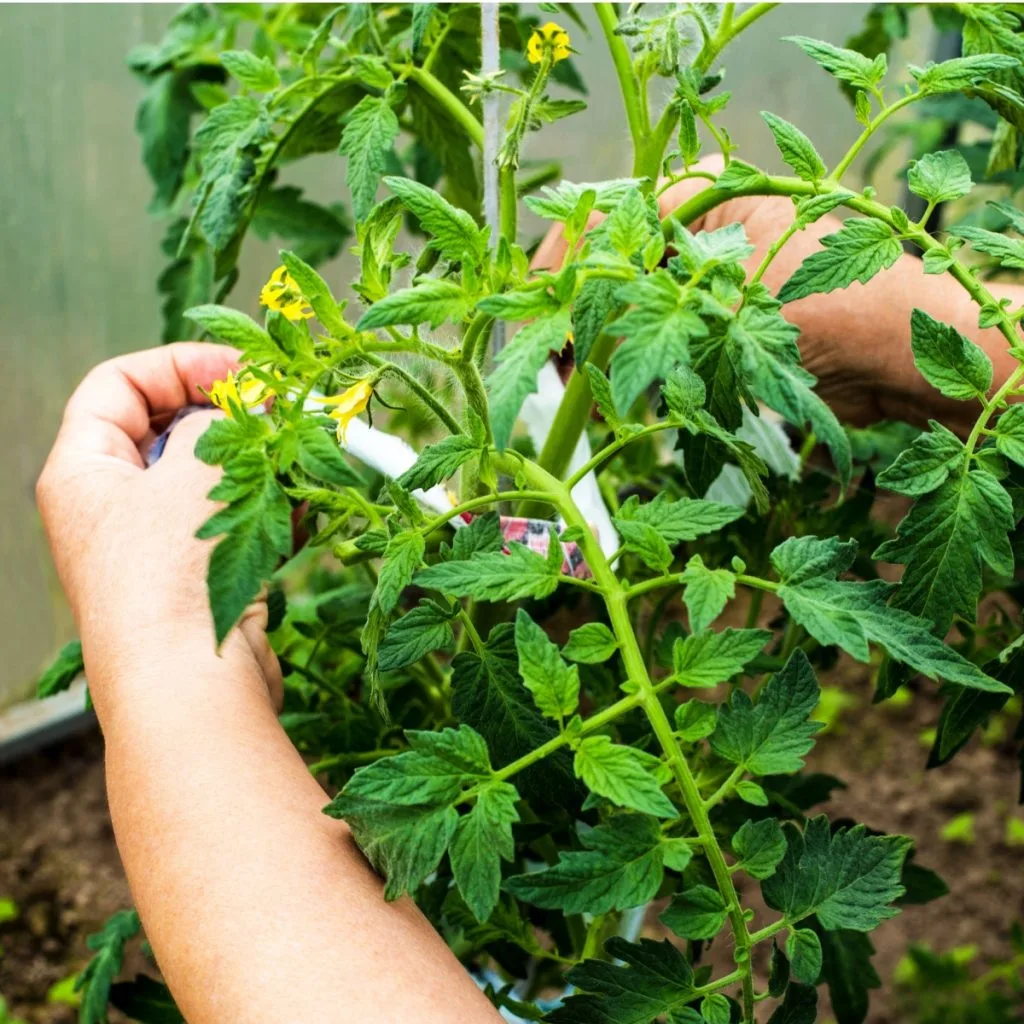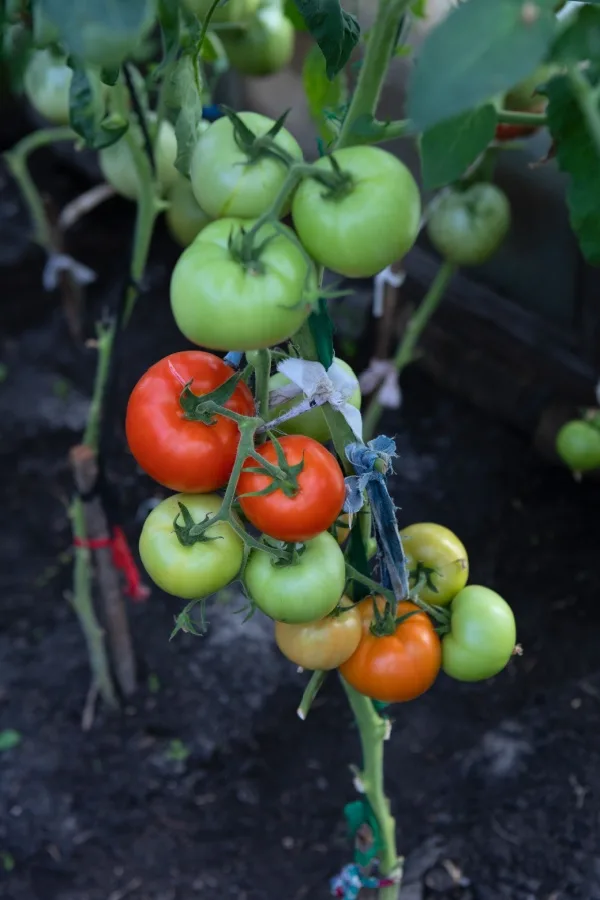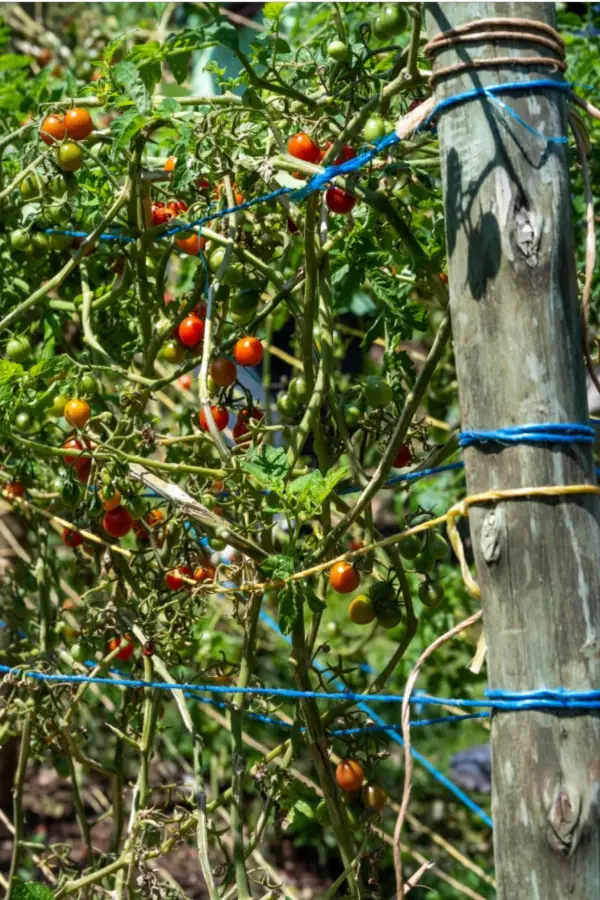Tying up tomato plants is one of the most important tasks that you can do if you want healthy plants and a good harvest. Tomato plants grow fast, and without support, they can become a tangled mess.
Stems that are left to sprawl on the ground are more likely to rot, get diseases, or be damaged by pests. Tying them up keeps the plant upright, improves air flow, and helps the fruit stay healthy and ripen evenly.
It also makes it easier for you to water, prune, and pick tomatoes when the time comes. Whether you’re growing a few plants in your backyard or a large row in the garden, tying tomato plants the right way will make a big difference in the success of your garden.

Start from the Stem When It’s Young
One common mistake is waiting too long to start tying up tomato plants. When the plant is young and still small, it’s easier to train the stem to grow straight up. If you wait until it’s large and full of fruit, the stems may already be bending or breaking.
It is best to place your support system like a cage or stake in the ground before you even plant. However, with some supports (like the traditional round tomato cages) this is nearly impossible.
Therefore, when you add your cage or stake after you plant, place it close to the base of the plant. Then, tie the main stem loosely to the support.
However, be sure not to tie it too tight. The stem needs room to grow and thicken. Tying from the stem gives your plant a solid base, and you can keep tying up new growth as the plant grows taller.
What Materials to Use for Tying Up Tomato Plants
The type of tie you use matters. You don’t want to use anything rough or stiff, because it could cut into the plant’s stem or branches. You also want something soft and stretchy that moves with the plant in the wind.
Years ago, gardeners often used old pantyhose for tying up tomato plants. The material was soft, easy to cut, and had some stretch. But it’s not as common now as pantyhose are no longer a common household item.
Although now there are better options, that are just as soft but stronger.

Although we have a complete article on The Best Materials To Use To Tie Up Tomatoes, here are some quick ideas.
- Stretchy yarn – Thick yarn works well and won’t dig into the stems. It’s also easy to cut and tie.
- Shredded t-shirt fabric – Cut old cotton t-shirts into strips. They’re strong, soft, and great for outdoor use.
- Garden Velcro – This reusable option sticks to itself and is easy to adjust as the plant grows.
- Soft jute twine – This works fine if used gently. It’s best to wrap it around the support first, then loosely around the stem.
No matter what material you use, always tie loosely. A good way to test it is to make sure you can fit your finger under the tie. The goal is to support the plant without holding it too tightly.
How to Support Branches with Heavy Tomatoes
When tomatoes start growing, the branches can get heavy. If you’re not tying up tomato plants regularly, a big branch full of fruit can snap. That’s a loss you can prevent with some extra support.
Use your soft ties to hold up fruit-heavy branches. Tie them to a nearby cage bar, stake, or string support. Don’t just tie near the end – tie close to the base of the branch where it meets the stem. That’s where the weight is pulling the most.
As your tomatoes grow, check your plants often and add extra ties if needed. This keeps the fruit hanging safely off the ground, which helps it ripen faster and stay clean.

Why Pruning Helps When Tying Up Tomato Plants
Pruning is a helpful part of tying up tomato plants. When you prune your plant, you remove the parts that don’t need to grow. This keeps the plant from getting too crowded and makes tying up the right branches easier.
Tomato plants grow extra shoots called suckers. These grow in between the main stem and side branches. If you leave them all, the plant gets too bushy. By removing some of these suckers, the plant focuses more energy on producing fruit instead of just leaves.
When the plant is pruned, air can move through the branches better. That lowers the chance of disease. It also makes it easier to find the important branches that need to be tied up.
You don’t have to prune everything at once. Take a little off each week. As you remove extra growth, keep tying up the branches that remain.
Standard Support Options
Before we talk about alternative methods, here are the two most common ways of tying up tomato plants:
Stakes
Drive a tall wooden or metal stake into the ground next to your tomato plant. As the plant grows taller, tie the main stem and branches to the stake every 8 to 12 inches. This is great for tomato plants that are pruned regularly and don’t grow too wide.

Cages
A tomato cage is a round wire frame that you place over the plant when it’s still small. The branches grow through the cage and use it for support. You can tie up tomato plant branches to the cage where needed, especially if fruit makes them heavy.
Both methods work well in small gardens. They help you tie up tomato plant branches quickly and keep them upright.
Stake-A-Cage
Combine the best methods of tying up your tomato plants and use a stake-a-cage. You can use a wooden stake or a metal t-post as the base.
Then use bolt cutters to cut goat or cattle panels down into 16″ wide sections for most tomato plants. For really large tomatoes, cut them at 24 inches wide. Keep the 50″ length for large tomato plants and cut them in half for smaller tomato varieties.
This tomato support method gives you the ability to tie your tomato branches to both the stake and the panel while still being able to easily prune and pick tomatoes during the harvest season.
See Full Article: How To Create An Amazing Low Cost Stake-A-Cage Tomato Support
The French Weave Method
If you’re growing several tomato plants in a row, the French weave method (also called the basket weave method) is a popular way to support them. It doesn’t use cages, and you don’t have to tie every plant to a separate stake.
Here’s how to do it:
- Place a strong stake at the start and end of your tomato row. Add more stakes every 2 or 3 plants.
- Run a strong line of twine along one side of the row, weaving it in and out between the plants.
- Wrap the twine tightly around each stake as you go to hold it in place.
- After you reach the last stake, repeat the process on the other side of the plants.

Now your tomato plants are held up between two lines of twine, like a sandwich. As the plants grow taller, add more layers of twine every 8 to 10 inches.
This method works well for large gardens because it saves time and materials. You still get strong support, and tying up tomato plants becomes much easier.
Helpful Tips for Tying Up Tomato Plants
- Check your ties often: As the plant grows, you may need to loosen or adjust your ties to prevent damage.
- Keep your tying material handy: A small bucket or pocket full of yarn or fabric strips makes it easy to tie up tomato plants as needed.
- Start early: The sooner you add support, the easier it is to train your plant.
- Use strong supports: Make sure your cages or stakes are firmly in the ground. A weak support can fall over and take the whole plant with it.
Tying up tomato plants the right way doesn’t take a lot of time, but it does require regular attention. The more you check and adjust your ties, the better your tomato plants will grow.
Whether you’re using shredded t-shirts, stretchy yarn, or trying out the French weave method, your garden will thank you with strong, healthy plants and a better harvest.
Follow Our Facebook Page For Even More Great Tomato Growing Tips! I Grow Tomatoes Facebook Page
I Grow Tomatoes is a website created for those who love all things about tomatoes – from planting and growing – to cooking and canning! We publish two articles every week, 52 weeks a year. Sign up today to follow via email! This article may contain affiliate links.
